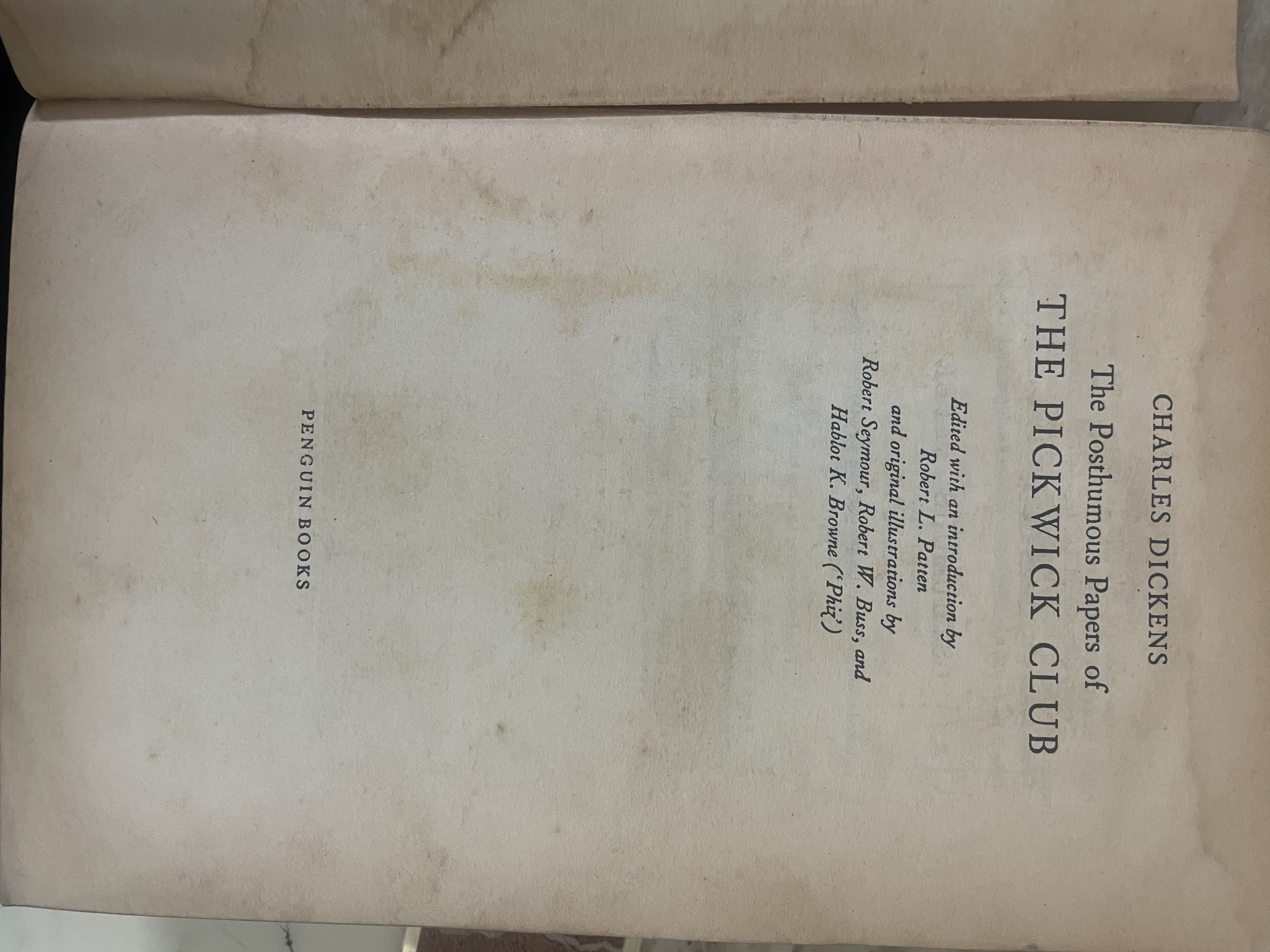The Pickwik Papers

About
Summary
Exquisite
TOC
Details
Related
URL
Images
Overview
The Pickwick Papers was Dickens's first novel, published in 1837. It was originally commissioned as a series of captions to accompany illustrations by caricaturist Robert Seymour. However, Dickens quickly took creative control, and the story evolved into a full-fledged novel.The Pickwick Papers, also known as The Posthumous Papers of the Pickwick Club, chronicles the adventures of Samuel Pickwick, Esquire, a kind, wealthy, and eccentric gentleman, and his fellow members of the Pickwick Club. The novel is structured as a series of loosely connected episodes, recounting the Pickwickians' travels throughout the English countryside.
Samuel Pickwick, the founder and perpetual president of the Pickwick Club, proposes that he and three other Pickwickians embark on journeys to locations outside of London and document their experiences for presentation to the club. These travels by coach throughout England form the main content of the novel.The Pickwick Club initially presents itself as an intellectual community dedicated to scientific knowledge. However, this aspect is quickly abandoned as the novel progresses. Dickens employs the club to satirize societal misunderstandings, highlighting the absurdity of a scientific club whose members prove incapable of the very activities they boast about. Despite Mr. Pickwick's advanced age, Sam Weller, a younger and lower-class character, demonstrates greater intelligence and good nature, ultimately benefiting Mr. Pickwick
Importance of Book
Dickens's breakthrough novel: The Pickwick Papers established Dickens as a major literary figure and launched his career.
A landmark in comic literature: The novel's humor, memorable characters, and episodic structure made it a popular and influential work of comic literature.
A social commentary on Victorian England: Dickens's satire of social institutions and class divisions provides valuable insights into Victorian society.
Key Themes
The celebration of human goodness and eccentricity: The Pickwickians, despite their flaws and foibles, are fundamentally good-hearted and well-intentioned. Dickens celebrates their innocence and enthusiasm, contrasting them with the cynicism and hypocrisy of the world around them.
The absurdity of social institutions: Dickens satirizes various social institutions, including the legal system, gentleman's clubs, and political organizations. He exposes their pomposity, incompetence, and tendency towards self-importance.
The importance of compassion and forgiveness: Pickwick's journey is one of moral growth, as he learns to temper his idealism with compassion and forgiveness. He extends kindness even to those who have wronged him, ultimately finding redemption and happiness.
The contrast between appearance and reality: The novel highlights the difference between outward appearances and inner character. Many of the characters claim to be something they are not, exposing the hypocrisy and superficiality of social conventions.
The value of friendship and community: The Pickwick Club represents a community of friends who support and care for one another. Dickens emphasizes the importance of human connection and the joy of shared experiences.
Cultural Significance
The Pickwick Papers holds significant cultural value as a portrayal of Victorian England. Its cultural significance lies in its satirical depiction of 19th-century English society, its memorable characters, and its exploration of themes such as social class, justice, and human nature. The novel captures the spirit of the era, reflecting its values, customs, and social tensions.
Effects on Society
Popularized serial fiction: The novel's serialization format contributed to the popularity of serial fiction, making literature more accessible to a wider audience.
Created a cultural phenomenon: The characters and catchphrases from The Pickwick Papers became ingrained in popular culture, influencing language, fashion, and entertainment.
Spurred social reform: Dickens's portrayal of social injustice and the plight of the poor helped to raise awareness of social problems and inspire reform movements.
Conclusion
The Pickwick Papers by Charles Dickens is a landmark novel that combines humor, social satire, and sentimental storytelling. Through its episodic structure, memorable characters, and exploration of universal themes, the book offers a rich and engaging portrayal of Victorian England. The Pickwick Papers remains a beloved classic, celebrated for its wit, warmth, and enduring appeal.
Table of Content
\"The Pickwick Papers,\" originally published in 1836, is Charles Dickens\'s first novel, presented in a series of episodic adventures featuring the whimsical Mr. Samuel Pickwick. In the 1972 edition, edited by Robert L. Patten, the narrative follows Mr. Pickwick and his friends from the Pickwick Club as they embark on a series of humorous and often absurd journeys across England.The novel explores themes of friendship, social class, and the quirks of human nature, offering a satirical look at Victorian society. With a cast of memorable characters?including the witty servant Sam Weller and a host of eccentric locals?the story is rich in comedy and social commentary. The episodic nature allows for various misadventures, including misunderstandings, legal troubles, and comical encounters.
Title
The Pickwik Papers
Author
Robet l Patten
Name of Publisher
Penguin Group
Publish Date
1972
Subject
It is Charles Dickens\'s first novel, presented in a series of episodic adventures featuring the whimsical Mr. Samuel Pickwick
Vintage
1948-2000
Category
Literary
Sub Category
Drama
Rarity
RARE
